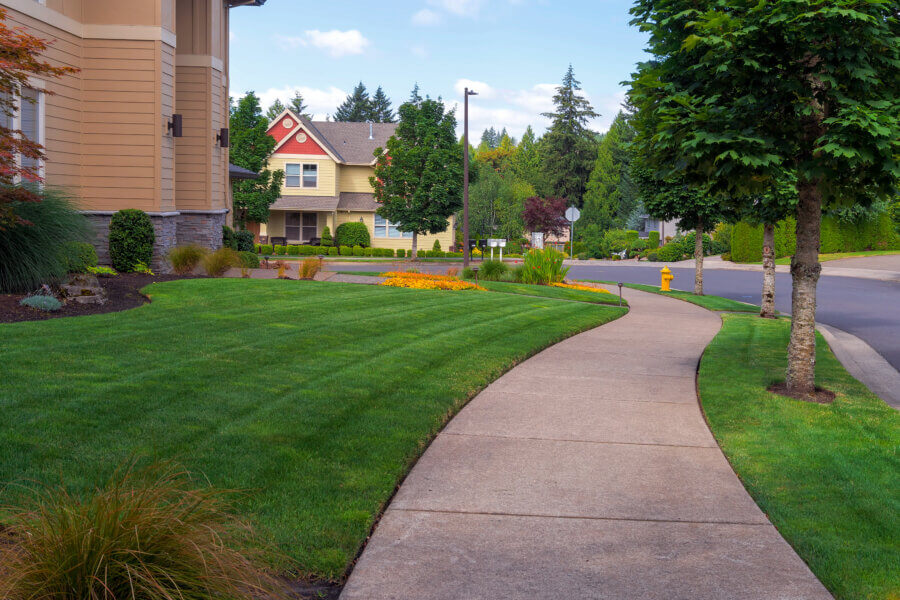
Sod Maintenance 101: How to Keep Your Lawn Healthy and Beautiful
Lawns require routine care and maintenance to keep them looking healthy and beautiful. Neglect your lawn and you’ll likely find it bald or riddled with weeds and disease. If you recently had a sod replacement in your yard, you may be wondering how best to care for your new lawn.
Following simple maintenance steps can help ensure that your new sod has the best chance of survival.
Limit Foot Traffic for the First Couple of Weeks
Despite the quality of the grass or sod installation, it’s important to remember that sod is perishable. To keep your new lawn looking its best, stay off the new sod until the first mowing, or approximately two weeks. Keep children and pets off the newly planted sod to allow ample time for the roots to get established and firmly entrenched. Walking on sod too early could lead to poor rooting or root failure.
Establish a Watering Schedule
Watering your new sod is one of the most important steps in maintaining a healthy lawn. Give your new sod a good soaking on the day of installation to penetrate the sod and approximately two inches of native soil.
During the first two weeks, give the sod a light watering two to three times a day to help establish the roots and prevent the sod from drying out. After the roots are established and you have mowed at least once, slow to a daily watering in the early morning hours. Gradually slow down on the days you water your lawn, depending on the weather.
It is possible to overwater sod. Newly installed sod has short roots which make it more difficult for them to retain moisture. To avoid overwatering, water in short bursts more frequently instead of giving your lawn large amounts of water at once.
Mow to an Optimal Height to Prevent Damage
While mowing your grass may seem like a simple enough task, the wrong mowing technique could result in damage to your lawn. The first mowing should take place once the sod has rooted, which can take an average of 10 to 14 days.
To determine if the sod is well-rooted, attempt to pull up a piece to see how secure it is attached to the topsoil. If established, prepare your mower by ensuring the blade is sharp. You can use either a rotary mower or a reel mower to mow your new sod.
Set the mowing height so that you do not remove more than one-third of the leaf blade while mowing. Avoid mowing the grass too short as this can cause scalping, resulting in damage to the new lawn during the important establishment period.
Feed the Lawn During the Growing Season
Fertilizing your sod regularly can help keep it looking healthy and vibrant. Strive to feed your lawn approximately three to four times throughout the growing period. Use a controlled-release or slow-release form of nitrogen, if possible, especially during applications in the spring and fall.
To avoid harming your new sod, always follow the manufacturer’s instructions written on the fertilizer package. It is also important to water-in the new sod’s fertilizer with each application. Fertilizing your lawn regularly can help further establish the roots and better support lawn growth.
Understand and Control Common Lawn Diseases
Despite your best efforts, your lawn could ultimately fall victim to a host of diseases. It’s important to recognize these lawn problems early on and treat them before they can cause extensive damage.
Lawn diseases can have many causes, ranging from cutting height and herbicide damage to soil compaction and nutrient chlorosis. These diseases can worsen when lawns develop heavy thatch, often during the winter with the buildup of roots, stems, and decomposed leaves.
Buy Sod from a Reputable Sod Farm
While there are multiple sod farms in Florida, Texas, and the surrounding areas, not all offer quality products. Whether you’re interested in Zoysia grass sod, Bahia sod, or other sod varieties, it’s important to select the right supplier.
Duda Sod is Florida’s leading sod supplier of grasses, offering a wide selection of sod varieties to buyers from Florida to Texas. Contact Duda Sod today to learn more or to get started on your next lawn project.